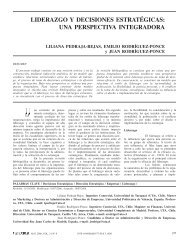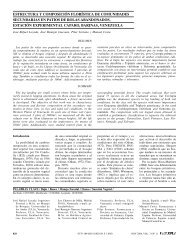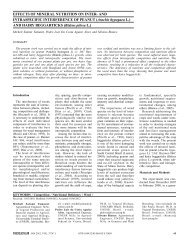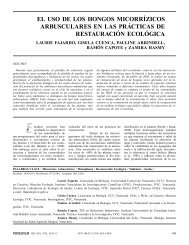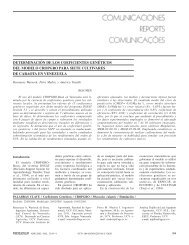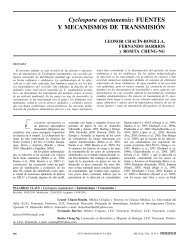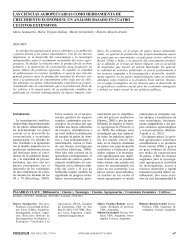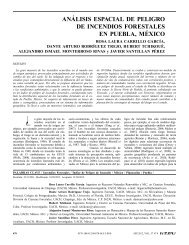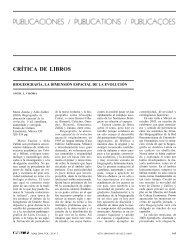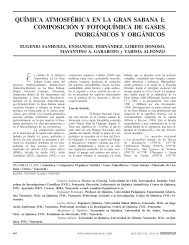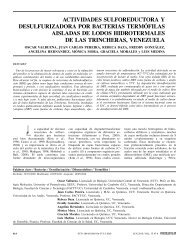effect of oxygen supply on water uptake in a melon ... - Interciencia
effect of oxygen supply on water uptake in a melon ... - Interciencia
effect of oxygen supply on water uptake in a melon ... - Interciencia
Create successful ePaper yourself
Turn your PDF publications into a flip-book with our unique Google optimized e-Paper software.
EFFECT OF OXYGEN SUPPLY ON WATER UPTAKE IN A MELON<br />
CROP UNDER SOILLESS CULTURE<br />
Pilar Mazuela<br />
SUMMARY<br />
Soilless culture permits more c<strong>on</strong>trol <strong>on</strong> fertigati<strong>on</strong> parameters,<br />
especially <strong>in</strong> arid and semi arid z<strong>on</strong>es with sal<strong>in</strong>e <strong>water</strong><br />
irrigati<strong>on</strong>. The objective <str<strong>on</strong>g>of</str<strong>on</strong>g> this experiment was to study the<br />
<str<strong>on</strong>g>effect</str<strong>on</strong>g> <str<strong>on</strong>g>of</str<strong>on</strong>g> potassium peroxide as an <str<strong>on</strong>g>oxygen</str<strong>on</strong>g> generator <strong>on</strong> <strong>water</strong><br />
c<strong>on</strong>sumpti<strong>on</strong>, yield and quality <str<strong>on</strong>g>of</str<strong>on</strong>g> a mel<strong>on</strong> (Cucumis melo L)<br />
crop. The work was carried out <strong>in</strong> a polycarb<strong>on</strong>ate greenhouse<br />
<strong>in</strong> the Azapa valley, extreme north <str<strong>on</strong>g>of</str<strong>on</strong>g> Chile. Root <str<strong>on</strong>g>oxygen</str<strong>on</strong>g>ati<strong>on</strong><br />
was provided by potassium peroxide. Two treatments were carried<br />
out: standard dissoluti<strong>on</strong> without (T0) or with (T1) <str<strong>on</strong>g>oxygen</str<strong>on</strong>g><br />
<str<strong>on</strong>g>supply</str<strong>on</strong>g>. The latter was applied <strong>on</strong>ce a week, at the last irrigati<strong>on</strong><br />
<str<strong>on</strong>g>of</str<strong>on</strong>g> the day. Fertirrigati<strong>on</strong> parameters, yield and fruit quality<br />
were measured. The results <strong>in</strong>dicate that apply<strong>in</strong>g potassium<br />
peroxide, used as an <str<strong>on</strong>g>oxygen</str<strong>on</strong>g> <str<strong>on</strong>g>supply</str<strong>on</strong>g>, stimulates <strong>water</strong> c<strong>on</strong>sumpti<strong>on</strong><br />
and improves significantly the <strong>water</strong> efficiency <strong>in</strong> mel<strong>on</strong> <strong>in</strong><br />
a soilless culture system irrigated with sal<strong>in</strong>e <strong>water</strong>.<br />
EFECTO DE LA APLICACIÓN DE UN OXIGENANTE SOBRE EL CONSUMO HÍDRICO EN UN CULTIVO DE<br />
MELON SIN SUELO<br />
Pilar Mazuela<br />
RESUMEN<br />
El sistema de cultivo s<strong>in</strong> suelo permite un mayor c<strong>on</strong>trol sobre<br />
los parámetros de fertirriego, especialmente en z<strong>on</strong>as áridas<br />
y semiáridas c<strong>on</strong> mala calidad de agua. El objetivo de este trabajo<br />
fue evaluar la aplicación de un oxigenante en un cultivo<br />
de melón (Cucumis melo L) y su efecto sobre la producción y<br />
c<strong>on</strong>sumo hídrico en un sistema de cultivo s<strong>in</strong> suelo. Para la oxigenación<br />
de las raíces se utilizó peróxido de potasio. Se hicier<strong>on</strong><br />
dos tratamientos. Se utilizó solución nutritiva estándar (T0)<br />
y solución nutritiva c<strong>on</strong> oxigenante (T1). Se evaluar<strong>on</strong> los parámetros<br />
de fertirrigación, producción y calidad de frutos. Los<br />
resultados <strong>in</strong>dican que la aplicación de peróxido de potasio utilizado<br />
como oxigenante estimula el c<strong>on</strong>sumo hídrico y mejora<br />
significativamente la eficiencia hídrica de un cultivo de melón<br />
en sistema de cultivo s<strong>in</strong> suelo.<br />
Introducti<strong>on</strong><br />
Horticultural technology has<br />
g<strong>on</strong>e through numerous changes<br />
<strong>in</strong> order to satisfy the demands<br />
<str<strong>on</strong>g>of</str<strong>on</strong>g> the c<strong>on</strong>sumers who, apart<br />
from seek<strong>in</strong>g products <str<strong>on</strong>g>of</str<strong>on</strong>g> good<br />
quality, value more and more<br />
the producti<strong>on</strong> processes, especially<br />
those related to envir<strong>on</strong>mental<br />
care. This is <str<strong>on</strong>g>of</str<strong>on</strong>g> special<br />
importance <strong>in</strong> z<strong>on</strong>es with poor<br />
<strong>water</strong> quality, as it permits provid<strong>in</strong>g<br />
the plant with the necessary<br />
nutrients for its growth and<br />
development, and at the same<br />
time ma<strong>in</strong>ta<strong>in</strong>s the salt balance<br />
<strong>in</strong> the rhizosphere with low volume<br />
leach<strong>in</strong>g irrigati<strong>on</strong>. Sal<strong>in</strong>ity<br />
affects crop growth because <str<strong>on</strong>g>of</str<strong>on</strong>g><br />
disorders <strong>in</strong> the absorpti<strong>on</strong> or<br />
distributi<strong>on</strong> <str<strong>on</strong>g>of</str<strong>on</strong>g> i<strong>on</strong>s that are essential<br />
for the development <str<strong>on</strong>g>of</str<strong>on</strong>g><br />
the plant (S<strong>on</strong>neveld, 2004),<br />
lead<strong>in</strong>g to a premature ag<strong>in</strong>g<br />
<str<strong>on</strong>g>of</str<strong>on</strong>g> the plant, whose <str<strong>on</strong>g>effect</str<strong>on</strong>g> is observed<br />
<strong>in</strong> the dim<strong>in</strong>uti<strong>on</strong> <str<strong>on</strong>g>of</str<strong>on</strong>g> productivity<br />
(Tester and Davenport,<br />
2003; Ashraf, 2004; Yamaguchi<br />
and Blumwald, 2005). Sodium<br />
is the predom<strong>in</strong>ant cati<strong>on</strong> <strong>in</strong><br />
the sal<strong>in</strong>ity <str<strong>on</strong>g>of</str<strong>on</strong>g> the majority <str<strong>on</strong>g>of</str<strong>on</strong>g><br />
soils <strong>in</strong> arid and semi-arid z<strong>on</strong>es<br />
(Kaya et al., 2007). Pardossi et<br />
al. (2002) c<strong>on</strong>cluded that the<br />
salt balance <strong>in</strong> the fertigati<strong>on</strong><br />
soluti<strong>on</strong> avoids excessive <strong>water</strong><br />
c<strong>on</strong>sumpti<strong>on</strong> under sal<strong>in</strong>ity<br />
c<strong>on</strong>diti<strong>on</strong>s without affect<strong>in</strong>g<br />
yield and quality <str<strong>on</strong>g>of</str<strong>on</strong>g> a mel<strong>on</strong><br />
crop. Another important factor<br />
is <str<strong>on</strong>g>oxygen</str<strong>on</strong>g>, as it has been shown<br />
that hypoxia has negative <str<strong>on</strong>g>effect</str<strong>on</strong>g>s<br />
<strong>on</strong> root growth and nutrient c<strong>on</strong>sumpti<strong>on</strong><br />
(Drew, 1983; Zer<strong>on</strong>i et<br />
al., 1983), with yield decrease<br />
(Cannell and Belford, 1980;<br />
Morard and Silvestre, 1996; Morard<br />
et al., 2000; Adams, 2002;<br />
Tesi et al. 2003). Urrestarazu<br />
and Mazuela (2005) <strong>in</strong>dicated<br />
that the applicati<strong>on</strong> <str<strong>on</strong>g>of</str<strong>on</strong>g> an <str<strong>on</strong>g>oxygen</str<strong>on</strong>g><br />
<str<strong>on</strong>g>supply</str<strong>on</strong>g> based <strong>on</strong> potassium<br />
peroxide is <str<strong>on</strong>g>effect</str<strong>on</strong>g>ive <strong>on</strong> plants<br />
sensitive to hypoxia, such as<br />
pepper, and improves the hydric<br />
efficiency <strong>in</strong> case <str<strong>on</strong>g>of</str<strong>on</strong>g> mel<strong>on</strong>.<br />
In the extreme north <str<strong>on</strong>g>of</str<strong>on</strong>g> Chile,<br />
at the Azapa valley, vegetable<br />
producti<strong>on</strong> is ma<strong>in</strong>ly dest<strong>in</strong>ed to<br />
<str<strong>on</strong>g>supply</str<strong>on</strong>g> large cities with vegetables<br />
dur<strong>in</strong>g the w<strong>in</strong>ter, as <strong>in</strong> the<br />
Mediterranean regi<strong>on</strong> (Urrestara-<br />
zu et al., 2008) and <strong>in</strong> areas <str<strong>on</strong>g>of</str<strong>on</strong>g><br />
the USA (Korkmaz and Default,<br />
2002). The average yield <str<strong>on</strong>g>of</str<strong>on</strong>g> a<br />
mel<strong>on</strong> crop is 3.5kg·m -1 , and the<br />
product is absent from the markets<br />
<strong>in</strong> the w<strong>in</strong>ter m<strong>on</strong>ths (May<br />
to October), thus present<strong>in</strong>g an<br />
attractive producti<strong>on</strong> alternative<br />
(Mazuela, 1999). Nevertheless,<br />
the ma<strong>in</strong> problem that limits<br />
horticultural producti<strong>on</strong> <strong>in</strong> the<br />
Azapa valley is the quantity and<br />
quality <str<strong>on</strong>g>of</str<strong>on</strong>g> irrigati<strong>on</strong> <strong>water</strong>. Kaya<br />
et al. (2007) c<strong>on</strong>cluded that apply<strong>in</strong>g<br />
potassium nitrate <strong>in</strong> the<br />
fertigati<strong>on</strong> had a positive <str<strong>on</strong>g>effect</str<strong>on</strong>g><br />
<strong>on</strong> salt tolerance, avoid<strong>in</strong>g sodium<br />
toxicity, and improved yield<br />
<strong>in</strong> mel<strong>on</strong> crop. Mel<strong>on</strong> is a crop<br />
moderately sensitive to sal<strong>in</strong>ity<br />
(Maas and H<str<strong>on</strong>g>of</str<strong>on</strong>g>fman, 1977)<br />
KEYWORDS / Azapa Valley / Chile / Grow<strong>in</strong>g Media / Oxygen Supply / Sal<strong>in</strong>e Water Management /<br />
Received: 08/17/2009. Modified: 08/25/2010. Accepted: 08/30/2009.<br />
Pilar Mazuela. Doctor <strong>in</strong><br />
Agr<strong>on</strong>omy, Master <str<strong>on</strong>g>of</str<strong>on</strong>g> Plant<br />
Nutriti<strong>on</strong> <strong>in</strong> Horticultural<br />
Crops Intensive, Universidad<br />
Politécnica de Cartagena,<br />
Spa<strong>in</strong>. Doctor <strong>on</strong> Intensive<br />
Agriculture <strong>in</strong> Semi-arid Areas,<br />
University <str<strong>on</strong>g>of</str<strong>on</strong>g> Almería,<br />
Spa<strong>in</strong>. Pr<str<strong>on</strong>g>of</str<strong>on</strong>g>essor, University<br />
<str<strong>on</strong>g>of</str<strong>on</strong>g> Tarapaca, Arica, Chile.<br />
Address: Departamento de<br />
Producción Agrícola, University<br />
<str<strong>on</strong>g>of</str<strong>on</strong>g> Tarapaca. Av Velasquez<br />
1775, Casilla 6-D, Arica,<br />
Chile. e-mail pmazuela@uta.cl<br />
OCT 2010, VOL. 35 Nº 10<br />
0378-1844/10/10/769-03 $ 3.00/0<br />
769
EFEITO DA APLICAÇÃO DE UM OXIGENANTE SOBRE O CONSUMO HÍDRICO EM UM CULTIVO DE MELÃO<br />
SEM SOLO<br />
Pilar Mazuela<br />
RESUMO<br />
O sistema de cultivo sem solo permite um maior c<strong>on</strong>trole sobre<br />
os parâmetros de fertirrigação, especialmente em z<strong>on</strong>as áridas<br />
e semiáridas com má qualidade de água. O objetivo deste<br />
trabalho foi avaliar a aplicação de um oxigenante em um cultivo<br />
de melão (Cucumis melo L) e seu efeito sobre a produção<br />
e c<strong>on</strong>sumo hídrico em um sistema de cultivo sem solo. Para a<br />
oxigenação das raízes se utilizou peróxido de potássio. Fizeramse<br />
dois tratamentos. Utilizou-se solução nutritiva estándar (T0)<br />
e solução nutritiva com oxigenante (T1). Avaliaram-se os parâmetros<br />
de fertirrigação, produção e qualidade de frutos. Os<br />
resultados <strong>in</strong>dicam que a aplicação de peróxido de potássio utilizado<br />
como oxigenante estimula o c<strong>on</strong>sumo hídrico e melhora<br />
significativamente a eficiência hídrica de um cultivo de melão<br />
em sistema de cultivo sem solo.<br />
which means that it supports<br />
an electric c<strong>on</strong>ductivity <str<strong>on</strong>g>of</str<strong>on</strong>g> up<br />
to 2.5dS·m -1 , without affect<strong>in</strong>g<br />
producti<strong>on</strong>. In soilless culture<br />
systems, better management <str<strong>on</strong>g>of</str<strong>on</strong>g><br />
sal<strong>in</strong>e <strong>water</strong> is possible because<br />
<str<strong>on</strong>g>of</str<strong>on</strong>g> greater c<strong>on</strong>trol at fertigati<strong>on</strong>,<br />
which reduces the sal<strong>in</strong>e <str<strong>on</strong>g>effect</str<strong>on</strong>g><br />
<strong>on</strong> the plants. (Navarro et<br />
al., 1999; Shann<strong>on</strong> and Grieve,<br />
1999; Romero et al., 2001; Savvas<br />
et al., 2005; Carmassi et<br />
al., 2007).<br />
The objective <str<strong>on</strong>g>of</str<strong>on</strong>g> this work<br />
was to study the <str<strong>on</strong>g>effect</str<strong>on</strong>g> <str<strong>on</strong>g>of</str<strong>on</strong>g> potassium<br />
peroxide as an <str<strong>on</strong>g>oxygen</str<strong>on</strong>g><br />
generator and the <str<strong>on</strong>g>effect</str<strong>on</strong>g> <strong>on</strong><br />
<strong>water</strong> c<strong>on</strong>sumpti<strong>on</strong> <strong>in</strong> producti<strong>on</strong><br />
and fruit quality <strong>in</strong> mel<strong>on</strong><br />
(Cucumus melo L) crop <strong>in</strong> a<br />
soilless culture system.<br />
Material and Methods<br />
The work was carried out <strong>in</strong><br />
a polycarb<strong>on</strong>ate greenhouse <strong>in</strong><br />
the Azapa valley, extreme north<br />
<str<strong>on</strong>g>of</str<strong>on</strong>g> Chile, us<strong>in</strong>g the Galia type<br />
mel<strong>on</strong>. Plants were transplanted<br />
<strong>on</strong> 08/14/2006 <strong>in</strong>to bags 1m<br />
l<strong>on</strong>g c<strong>on</strong>ta<strong>in</strong><strong>in</strong>g as a substrate 25<br />
liters <str<strong>on</strong>g>of</str<strong>on</strong>g> diatomite (skelet<strong>on</strong> fossils<br />
with 95% silica), with three<br />
plants per bag. Harvest ended<br />
<strong>on</strong> 12/28/2006. The irrigati<strong>on</strong><br />
<strong>water</strong> c<strong>on</strong>ta<strong>in</strong>ed (mmol·l -1 )<br />
HCO 3<br />
-<br />
(2.9), Cl - (3.3), Na + (2.8),<br />
NO 3<br />
-<br />
(0.1), SO 4<br />
2-<br />
(2.3), Ca 2+<br />
(3.9), Mg 2+ (1.9) and K + (0.3).<br />
Two treatments were carried<br />
out. The c<strong>on</strong>trol treatment (T0)<br />
<strong>on</strong>ly the standard nutrient soluti<strong>on</strong>,<br />
similar to that reported by<br />
S<strong>on</strong>neveld and Straver (1994),<br />
was used. In the sec<strong>on</strong>d treatment<br />
(T1), Liberoxi® (1g·l -1 )<br />
was added <strong>on</strong>ce a week to the<br />
same nutrient soluti<strong>on</strong>. Liberoxy®<br />
c<strong>on</strong>ta<strong>in</strong>s ~7% potassium<br />
peroxide. A dose <str<strong>on</strong>g>of</str<strong>on</strong>g> 1g·l -1 was<br />
used accord<strong>in</strong>g to<br />
the recommendati<strong>on</strong>s<br />
<str<strong>on</strong>g>of</str<strong>on</strong>g> Urrestarazu<br />
and Mazuela<br />
(2005). Fertigati<strong>on</strong><br />
was supplied with a<br />
localised irrigati<strong>on</strong><br />
system. Every week,<br />
for each treatment,<br />
dra<strong>in</strong>ed <strong>water</strong> and<br />
dripp<strong>in</strong>gs were sampled<br />
and determ<strong>in</strong>ati<strong>on</strong>s<br />
were made <str<strong>on</strong>g>of</str<strong>on</strong>g><br />
the volume, <str<strong>on</strong>g>of</str<strong>on</strong>g> the<br />
pH with a mod. 2000 pH meter<br />
(Cris<strong>on</strong>, Barcel<strong>on</strong>a, Spa<strong>in</strong>),<br />
and <str<strong>on</strong>g>of</str<strong>on</strong>g> the electrical c<strong>on</strong>ductivity<br />
(EC) mod. 525 c<strong>on</strong>ductivity<br />
meter (Cris<strong>on</strong>, Barcel<strong>on</strong>a,<br />
Spa<strong>in</strong>). Chemical analyses <str<strong>on</strong>g>of</str<strong>on</strong>g><br />
drippers and dra<strong>in</strong>age were also<br />
performed weekly accord<strong>in</strong>g to<br />
Gil de Carrasco et al. (1994),<br />
us<strong>in</strong>g a model 2000i/SP liquid<br />
chromatograph (Di<strong>on</strong>ex, Sunnyvale,<br />
CA, USA) equipped with<br />
AS4A ani<strong>on</strong>ic and CS12 cati<strong>on</strong>ic<br />
columns (data not shown). Water<br />
c<strong>on</strong>sumpti<strong>on</strong> was calculated as<br />
the difference <strong>in</strong> the percentage<br />
<str<strong>on</strong>g>of</str<strong>on</strong>g> <strong>water</strong> dra<strong>in</strong>ed <strong>in</strong> the two<br />
treatments. The <strong>water</strong> efficiency<br />
was calculated as the volume <str<strong>on</strong>g>of</str<strong>on</strong>g><br />
<strong>water</strong> c<strong>on</strong>sumed per kg <str<strong>on</strong>g>of</str<strong>on</strong>g> fruit<br />
produced.<br />
Two different groups <str<strong>on</strong>g>of</str<strong>on</strong>g><br />
fruits, marketable and n<strong>on</strong>marketable,<br />
were established<br />
us<strong>in</strong>g EU regulati<strong>on</strong> L 100/11<br />
as standard (OJUE, 2001). For<br />
fruit quality, firmness (FF) was<br />
measured <strong>on</strong> three mel<strong>on</strong> fruits<br />
per replicati<strong>on</strong> and treatment<br />
us<strong>in</strong>g a pressuretester (7.9mm<br />
diameter pressure-tester needle)<br />
and expressed <strong>in</strong> terms <str<strong>on</strong>g>of</str<strong>on</strong>g> kg·m 2<br />
<str<strong>on</strong>g>of</str<strong>on</strong>g> crop surface. Total soluble<br />
solid (SS) c<strong>on</strong>tents were measured<br />
<strong>in</strong> the juice from three<br />
fruits per replicati<strong>on</strong>, us<strong>in</strong>g a<br />
Table I<br />
Fertigati<strong>on</strong> parameters, total <strong>water</strong> <strong>uptake</strong> and <strong>water</strong><br />
efficiency <strong>in</strong> mel<strong>on</strong> crop without (T0) and with (T1) <str<strong>on</strong>g>oxygen</str<strong>on</strong>g><br />
<str<strong>on</strong>g>supply</str<strong>on</strong>g><br />
Dra<strong>in</strong>age<br />
Treatment EC (dS m -1 ) pH % dra<strong>in</strong>age<br />
refractometer, and expressed <strong>in</strong><br />
ºBrix. Dry matter (DM) was<br />
also measured.<br />
Each experiment was c<strong>on</strong>ducted<br />
us<strong>in</strong>g a randomized complete<br />
block design us<strong>in</strong>g two<br />
treatments and three replicati<strong>on</strong>s.<br />
Each plot (experimental unit)<br />
had 12 mel<strong>on</strong> plants. S<strong>in</strong>gle t-<br />
Student probability was used<br />
to separate the means <str<strong>on</strong>g>of</str<strong>on</strong>g> treatments.<br />
The experimental designs<br />
and data analysis were based<br />
<strong>on</strong> the procedure described by<br />
Little and Hills (1987) and Petersen<br />
(1994). Calculati<strong>on</strong>s were<br />
made with a statistical package<br />
(Stagraphics, 1999).<br />
Results and Discussi<strong>on</strong><br />
Table I shows fertigati<strong>on</strong> parameters,<br />
<strong>water</strong> c<strong>on</strong>sumpti<strong>on</strong><br />
and efficiency. Water <strong>uptake</strong><br />
<str<strong>on</strong>g>of</str<strong>on</strong>g> T1 was significantly higher<br />
than that <str<strong>on</strong>g>of</str<strong>on</strong>g> the c<strong>on</strong>trol. This<br />
result agrees with that reported<br />
<strong>in</strong> tomato (Morard et al., 2000)<br />
and sweet pepper (Urrestarazu<br />
and Mazuela, 2005) when<br />
plants were grown <strong>in</strong> soilless<br />
culture with <str<strong>on</strong>g>oxygen</str<strong>on</strong>g> <str<strong>on</strong>g>supply</str<strong>on</strong>g>.<br />
The values <str<strong>on</strong>g>of</str<strong>on</strong>g> EC, pH and the<br />
percentage <str<strong>on</strong>g>of</str<strong>on</strong>g> dra<strong>in</strong>age are <str<strong>on</strong>g>of</str<strong>on</strong>g><br />
<strong>in</strong>terest, because <strong>in</strong> practice<br />
they are used by growers and<br />
Water <strong>uptake</strong><br />
(l·m -2 )<br />
Water efficiency<br />
(l· kg -1 )<br />
T0 2.64 7.82 18.20 170.39 63.57<br />
T1 3.07 7.79 14.97 176.80 53.25<br />
P ** ns * * **<br />
*, **, and ns: P≤0.05, P≤0.01, P≤0.001. and not significant, respectively.<br />
technicians to c<strong>on</strong>trol the horticultural<br />
crops <strong>in</strong> soilless culture<br />
(Urrestarazu, 2004), and thus,<br />
it is useful to know whether<br />
after treatment applicati<strong>on</strong>s the<br />
values <str<strong>on</strong>g>of</str<strong>on</strong>g> these parameters are<br />
different. There were significant<br />
differences between treatments<br />
<strong>in</strong> EC, percentage <str<strong>on</strong>g>of</str<strong>on</strong>g> dra<strong>in</strong>age<br />
and <strong>water</strong> efficiency, which was<br />
significantly different to the<br />
c<strong>on</strong>trol and l<strong>in</strong>ked to a higher<br />
<strong>water</strong> <strong>uptake</strong>. A decrease <strong>in</strong> the<br />
<str<strong>on</strong>g>oxygen</str<strong>on</strong>g> c<strong>on</strong>tent <str<strong>on</strong>g>of</str<strong>on</strong>g> the nutrient<br />
soluti<strong>on</strong>, together with a corresp<strong>on</strong>d<strong>in</strong>g<br />
<strong>in</strong>crease <strong>in</strong> the respirati<strong>on</strong><br />
rate at a certa<strong>in</strong> time <str<strong>on</strong>g>of</str<strong>on</strong>g><br />
the day (Hansen, 1977) could<br />
limit growth, at least for part<br />
<str<strong>on</strong>g>of</str<strong>on</strong>g> the day, unless the nutrient<br />
soluti<strong>on</strong> <str<strong>on</strong>g>oxygen</str<strong>on</strong>g> c<strong>on</strong>tent was<br />
<strong>in</strong>creased, suggest<strong>in</strong>g the need<br />
to <strong>in</strong>crease the <str<strong>on</strong>g>oxygen</str<strong>on</strong>g> c<strong>on</strong>tent<br />
around midday.<br />
This suggests that the <str<strong>on</strong>g>supply</str<strong>on</strong>g><br />
<str<strong>on</strong>g>of</str<strong>on</strong>g> <str<strong>on</strong>g>oxygen</str<strong>on</strong>g> as potassium peroxide<br />
<strong>in</strong> the nutrient soluti<strong>on</strong> stimulates<br />
<strong>water</strong> c<strong>on</strong>sumpti<strong>on</strong> under<br />
high sal<strong>in</strong>ity c<strong>on</strong>diti<strong>on</strong>s, as reported<br />
by Kaya et al. (2003,<br />
2007). More temporarily available<br />
<str<strong>on</strong>g>oxygen</str<strong>on</strong>g> could be the reas<strong>on</strong><br />
for a higher <strong>water</strong> absorpti<strong>on</strong>,<br />
and us<strong>in</strong>g the <str<strong>on</strong>g>oxygen</str<strong>on</strong>g> depleti<strong>on</strong><br />
c<strong>on</strong>cept <str<strong>on</strong>g>of</str<strong>on</strong>g> as def<strong>in</strong>ed by Gilderød<br />
and Adams (1983), a high-<br />
770 OCT 2010, VOL. 35 Nº 10
er c<strong>on</strong>sumpti<strong>on</strong> <strong>in</strong> T1 can be<br />
assumed. S<strong>on</strong>neveld and Voogt<br />
(2001) have shown that roots<br />
are versatile enough to take up<br />
<strong>water</strong> and nutrients from the<br />
parts <strong>in</strong> better c<strong>on</strong>diti<strong>on</strong>s, while<br />
the rest <str<strong>on</strong>g>of</str<strong>on</strong>g> the roots are under<br />
more limit<strong>in</strong>g c<strong>on</strong>diti<strong>on</strong>s. This<br />
does not affect producti<strong>on</strong>. Even<br />
though these studies have been<br />
carried out to study <strong>water</strong> and<br />
nutrients, they could be equally<br />
valid for <str<strong>on</strong>g>oxygen</str<strong>on</strong>g> absorpti<strong>on</strong>. Further<br />
research <strong>on</strong> the <str<strong>on</strong>g>effect</str<strong>on</strong>g> <str<strong>on</strong>g>of</str<strong>on</strong>g><br />
<str<strong>on</strong>g>oxygen</str<strong>on</strong>g> c<strong>on</strong>tent distributi<strong>on</strong> <strong>in</strong><br />
the root envir<strong>on</strong>ment <strong>on</strong> certa<strong>in</strong><br />
crop parameters, as has been<br />
d<strong>on</strong>e for other fertigati<strong>on</strong> studies<br />
are needed.<br />
Table II shows yield and fruit<br />
quality parameters. There was<br />
no significant differences <strong>in</strong><br />
yield and quality <str<strong>on</strong>g>of</str<strong>on</strong>g> mel<strong>on</strong> with<br />
<str<strong>on</strong>g>oxygen</str<strong>on</strong>g> <str<strong>on</strong>g>supply</str<strong>on</strong>g>. These results<br />
agree with those reported by<br />
B<strong>on</strong>achela et al. (2010) and are<br />
different from those reported<br />
by Urrestarazu and Mazuela<br />
(2005), where <str<strong>on</strong>g>oxygen</str<strong>on</strong>g> enrichment<br />
significantly <strong>in</strong>creased the<br />
total producti<strong>on</strong> and number <str<strong>on</strong>g>of</str<strong>on</strong>g><br />
fruits. The observed resp<strong>on</strong>se<br />
could be attributed to the absence<br />
<str<strong>on</strong>g>of</str<strong>on</strong>g> an <str<strong>on</strong>g>oxygen</str<strong>on</strong>g> deficiency <strong>in</strong><br />
T0, or to hypoxic periods <str<strong>on</strong>g>of</str<strong>on</strong>g> <strong>in</strong>tensity<br />
or durati<strong>on</strong> <strong>in</strong>sufficient to<br />
affect productivity significantly.<br />
Growers and technicians must<br />
c<strong>on</strong>sider that the depleti<strong>on</strong> <str<strong>on</strong>g>of</str<strong>on</strong>g> the<br />
<str<strong>on</strong>g>oxygen</str<strong>on</strong>g> available to the roots<br />
occurs gradually under field<br />
c<strong>on</strong>diti<strong>on</strong>s. Moreover, for high<br />
value crops, the determ<strong>in</strong>ati<strong>on</strong><br />
<str<strong>on</strong>g>of</str<strong>on</strong>g> periods <str<strong>on</strong>g>of</str<strong>on</strong>g> <strong>in</strong>creas<strong>in</strong>g demand<br />
for <str<strong>on</strong>g>oxygen</str<strong>on</strong>g>, or know<strong>in</strong>g when<br />
hypoxic c<strong>on</strong>diti<strong>on</strong>s may occur,<br />
is <str<strong>on</strong>g>of</str<strong>on</strong>g> great <strong>in</strong>terest as it permits<br />
adapt<strong>in</strong>g crop management practices<br />
or the use <str<strong>on</strong>g>of</str<strong>on</strong>g> <str<strong>on</strong>g>oxygen</str<strong>on</strong>g> enrichment<br />
techniques (Amstr<strong>on</strong>g<br />
and Drew, 2002).<br />
C<strong>on</strong>clusi<strong>on</strong><br />
Oxygen <str<strong>on</strong>g>supply</str<strong>on</strong>g> has an <str<strong>on</strong>g>effect</str<strong>on</strong>g><br />
<strong>on</strong> <strong>water</strong> <strong>uptake</strong> and improves<br />
<strong>water</strong> efficiency <strong>in</strong> terms <str<strong>on</strong>g>of</str<strong>on</strong>g> kg<br />
produced per liter <str<strong>on</strong>g>of</str<strong>on</strong>g> <strong>water</strong> c<strong>on</strong>sumed.<br />
There were no differences<br />
<strong>in</strong> yield and fruit quality,<br />
which could be attributed to the<br />
absence <str<strong>on</strong>g>of</str<strong>on</strong>g> an <str<strong>on</strong>g>oxygen</str<strong>on</strong>g> deficiency<br />
<strong>in</strong> the c<strong>on</strong>trol treatment, or to<br />
hypoxic periods <str<strong>on</strong>g>of</str<strong>on</strong>g> <strong>in</strong>sufficient<br />
<strong>in</strong>tensity or durati<strong>on</strong> to significantly<br />
affect productivity.<br />
Table II<br />
Yield and quality parameters <strong>in</strong> mel<strong>on</strong> crop<br />
without (T0) and with (T1) <str<strong>on</strong>g>oxygen</str<strong>on</strong>g> <str<strong>on</strong>g>supply</str<strong>on</strong>g><br />
Yield<br />
Quality<br />
SS (ºBrix) FF (kg) % DM<br />
Treatment kg·m 2 Nº<br />
fruits/m -2<br />
T0 2.68 2.50 14.89 3.20 9.66<br />
T1 3.32 3.75 14.56 3.13 9.68<br />
P ns ns ns ns ns<br />
ns: not significant.<br />
SS: soluble solids, FF: fruit firmness, DM: dry matter.<br />
Acknowledgements<br />
The author thanks J.C. Flores<br />
(IAI-UTA) for critical discussi<strong>on</strong><br />
<str<strong>on</strong>g>of</str<strong>on</strong>g> the manuscript. This<br />
work was supported by the<br />
University <str<strong>on</strong>g>of</str<strong>on</strong>g> Tarapaca, Arica,<br />
Chile, project UTA 9720-08.<br />
References<br />
Adams P (2002) Nutriti<strong>on</strong>al c<strong>on</strong>trol <strong>in</strong><br />
hydrop<strong>on</strong>ics. In Savvas M, Passam<br />
H (Eds.) Hydrop<strong>on</strong>ics Producti<strong>on</strong><br />
<str<strong>on</strong>g>of</str<strong>on</strong>g> Vegetables and Ornamentals.<br />
Embryo Publicati<strong>on</strong>s.<br />
Athens, Greece. pp. 211-262.<br />
Armstr<strong>on</strong>g W, Drew MC (2002) Root<br />
growth and metabolism under<br />
<str<strong>on</strong>g>oxygen</str<strong>on</strong>g> deficiency. In Waisel Y,<br />
Eshel A, Kafkafi U (Eds.) Plant<br />
Roots. The Hidden Half. Dekker,<br />
New York, USA. pp. 729-761.<br />
Ashraf M (2004) Some important<br />
physiological selecti<strong>on</strong> criteria<br />
for salt tolerance <strong>in</strong> plants. Flora<br />
199: 361-376.<br />
B<strong>on</strong>achela S, Quesada J, Acuña RA,<br />
Magán JJ, Marfa O (2010) Oxyfertigati<strong>on</strong><br />
<str<strong>on</strong>g>of</str<strong>on</strong>g> a greenhouse tomato<br />
crop grown <strong>on</strong> rockwool<br />
slabs and irrigated with treated<br />
waste<strong>water</strong>: Oxygen c<strong>on</strong>tent dynamics<br />
and crop resp<strong>on</strong>se. Agric.<br />
Water Manag. 97: 433-438.<br />
Carmassi G, Incrocci L, Magg<strong>in</strong>i<br />
R, Malorgio F, Togn<strong>on</strong>i F, Pardossi<br />
A (2007) An aggregated<br />
model for <strong>water</strong> requirements<br />
<str<strong>on</strong>g>of</str<strong>on</strong>g> greenhouse tomato grown <strong>in</strong><br />
closed rockwool culture with sal<strong>in</strong>e<br />
<strong>water</strong>. Agric. Water Manag.<br />
88: 73-82.<br />
Cannell RQ, Belford RK (1980) Effect<br />
<str<strong>on</strong>g>of</str<strong>on</strong>g> watterlogg<strong>in</strong>g at different stages<br />
<str<strong>on</strong>g>of</str<strong>on</strong>g> development <strong>on</strong> the growth<br />
and yield <str<strong>on</strong>g>of</str<strong>on</strong>g> w<strong>in</strong>ter oilseed rape<br />
(Brassica napus L.). J. Sci. Food<br />
Agric. 31: 963-965.<br />
Drew MC (1983) Plant <strong>in</strong>jury and adaptati<strong>on</strong><br />
to <str<strong>on</strong>g>oxygen</str<strong>on</strong>g> deficiency <strong>in</strong><br />
the root envir<strong>on</strong>ment: A review.<br />
Plant Soil 75: 179-199.<br />
Gil de Carrasco C, Guzmán M, Lorente<br />
FA, Urrestarazu M (1994)<br />
Xylem sap extracti<strong>on</strong>: A method.<br />
Comm. Soil Sci. Plant Anal. 27:<br />
1859-1874.<br />
Gilderød HR, Adams P (1983) Diurnal<br />
variati<strong>on</strong>s <strong>in</strong> the <str<strong>on</strong>g>oxygen</str<strong>on</strong>g>t<br />
c<strong>on</strong>tent and acid requement <str<strong>on</strong>g>of</str<strong>on</strong>g> recirculat<strong>in</strong>g<br />
nutrients soluti<strong>on</strong>s and<br />
it the <strong>uptake</strong> <str<strong>on</strong>g>of</str<strong>on</strong>g> <strong>water</strong> and potassium<br />
by cucumber and tomato<br />
plants. Sci. Hort. 21: 311-321.<br />
Hansen GK (1977) Adapti<strong>on</strong> to photosynthesis<br />
and diurnal oscillati<strong>on</strong><br />
<str<strong>on</strong>g>of</str<strong>on</strong>g> root respirati<strong>on</strong> rates for Lolium<br />
multiflorum. Physiol. Plant<br />
39: 275-279.<br />
Kaya C, Higgs D, Ince F, Murillo-<br />
Amador B, Fakir A, Sakar E<br />
(2003) Ameliorative <str<strong>on</strong>g>effect</str<strong>on</strong>g>s <str<strong>on</strong>g>of</str<strong>on</strong>g><br />
potassium phosphate <strong>on</strong> salt<br />
stressed pepper and cucumber. J.<br />
Plant Nutr. 26: 807-820.<br />
Kaya C, Tuna AL, Ashraf M, Altunlu<br />
H (2007) Improved salt tolerance<br />
<str<strong>on</strong>g>of</str<strong>on</strong>g> mel<strong>on</strong> (Cucumis melo L.) by<br />
the additi<strong>on</strong> <str<strong>on</strong>g>of</str<strong>on</strong>g> prol<strong>in</strong>e and potassium<br />
nitrate. Env. Exp. Bot. 60:<br />
397-403.<br />
Korkmaz A, Dufault RJ (2002)<br />
Short-term cyclic cold temperature<br />
stress <strong>on</strong> <strong>water</strong>mel<strong>on</strong> yield.<br />
HortScience 37: 487-489.<br />
Little TM, Hills FJ (1987) Métodos<br />
Estadísticos para la Investigación<br />
en la Agricultura. Trillas.<br />
México. 270 pp.<br />
Maas EV, H<str<strong>on</strong>g>of</str<strong>on</strong>g>fman GJ (1977) Crop<br />
salt tolerance. Current assessment.<br />
J. Irrig. Dra<strong>in</strong>. Div. 103:<br />
115-134.<br />
Mazuela P (1999) Desarrollo agrícola<br />
en Arica: Innovación y cambio<br />
de mentalidad. Temas Regi<strong>on</strong>ales<br />
6: 156-166.<br />
Morard P, Lacoste L, Silvestre J<br />
(2000) Effect <str<strong>on</strong>g>of</str<strong>on</strong>g> <str<strong>on</strong>g>oxygen</str<strong>on</strong>g> deficiency<br />
<strong>on</strong> <strong>uptake</strong> <str<strong>on</strong>g>of</str<strong>on</strong>g> <strong>water</strong> and<br />
m<strong>in</strong>eral nutrients by tomato<br />
plants <strong>in</strong> soilless culture. J. Plant<br />
Nutr. 23: 1063-1078.<br />
Morard P, Silvester J (1996) Plant<br />
<strong>in</strong>jury due to <str<strong>on</strong>g>oxygen</str<strong>on</strong>g> deficiency<br />
<strong>in</strong> the root envir<strong>on</strong>ment <str<strong>on</strong>g>of</str<strong>on</strong>g> soilless<br />
culture: a review. Plant Soil<br />
184: 243-254.<br />
OJUE (2001), Commissi<strong>on</strong> regulati<strong>on</strong><br />
(EC) N° 1615/2001 and<br />
N° 717/2001. Official Journal <str<strong>on</strong>g>of</str<strong>on</strong>g><br />
European Communite. Brussels,<br />
Belgium.<br />
Navarro JM, Botella MA, Mart<strong>in</strong>ez V<br />
(1999) Yield and fruit quality <str<strong>on</strong>g>of</str<strong>on</strong>g><br />
mel<strong>on</strong> plants grown under sal<strong>in</strong>e<br />
c<strong>on</strong>diti<strong>on</strong>s <strong>in</strong> relati<strong>on</strong> to phosphate<br />
and calcium nutriti<strong>on</strong>. J.<br />
Hort. Sci. Biotecnol. 74: 573-578.<br />
Pardossi A, Malorgio F, Incrocci L,<br />
Campiotti CA, Togn<strong>on</strong>i F (2002)<br />
A compars<strong>on</strong> between tho methods<br />
to c<strong>on</strong>trol nutrient delivery<br />
to greenhouse mel<strong>on</strong>s grown <strong>in</strong><br />
reciculat<strong>in</strong>g nutrient soluti<strong>on</strong> culture.<br />
Sci. Hort. 92: 89-95.<br />
Petersen RG (1994) Agricultural Field<br />
Experiments. Dekker. New York,<br />
USA.409 pp.<br />
Romero AR, Soria T, Cuartero J<br />
(2001) Tomato plant <strong>water</strong> <strong>uptake</strong><br />
and plant <strong>water</strong> relati<strong>on</strong>ships<br />
under sal<strong>in</strong>e growth c<strong>on</strong>diti<strong>on</strong>s.<br />
Plant Sci. 160: 265-272.<br />
Savvas D, Meletiou G, Margariti S,<br />
Tsirogiannis I (2005) Modell<strong>in</strong>g<br />
the relati<strong>on</strong>ship between <strong>water</strong><br />
<strong>uptake</strong> by Cucumber and NaCl<br />
accumulati<strong>on</strong> <strong>in</strong> a closed hydrop<strong>on</strong>ic<br />
system. HortScience 40:<br />
802-807.<br />
Shann<strong>on</strong> MC, Grieve CM (1999)<br />
Tolerance <str<strong>on</strong>g>of</str<strong>on</strong>g> vegetable crops to<br />
sal<strong>in</strong>ity. Sci. Hort. 78: 5-38.<br />
S<strong>on</strong>neveld C (2004) La nutrición m<strong>in</strong>eral<br />
y sal<strong>in</strong>idad en los cultivos<br />
s<strong>in</strong> suelo: su manejo. In Urrestarazu<br />
M (Ed.) Tratado de Cultivo<br />
s<strong>in</strong> Suelo. 3 rd ed. Mundi-Prensa.<br />
Madrid, Spa<strong>in</strong>. 305-367 pp.<br />
S<strong>on</strong>neveld C, Straver N (1994) Nutrient<br />
Soluti<strong>on</strong>s for Vegetables<br />
and Fflower Growth <strong>in</strong> Water<br />
Substrates. 10 th ed. Proefstati<strong>on</strong><br />
voor Tu<strong>in</strong>bouw <strong>on</strong>der Glas te<br />
Naaldiwjk. Nº 8. 45 pp.<br />
S<strong>on</strong>neveld C, Voogt W (2001)Chemical<br />
analysis <strong>in</strong> substrate systems<br />
and hydrop<strong>on</strong>ics use and <strong>in</strong>terpretati<strong>on</strong>.<br />
Acta Hort. 548: 247-<br />
259.<br />
Statgraphics (1999) STATGRAPHICS<br />
Plus for W<strong>in</strong>dows 4.1. Statistical<br />
Graphics Crop. Rockville, MD,<br />
USA.<br />
Tesi R, Lenzi A, Lombardi P (2003)<br />
Effect <str<strong>on</strong>g>of</str<strong>on</strong>g> sal<strong>in</strong>ity and <str<strong>on</strong>g>oxygen</str<strong>on</strong>g> level<br />
<strong>on</strong> lettuce grown <strong>in</strong> a float<strong>in</strong>g<br />
system. Acta Hort. 609: 383-387.<br />
Tester M, Davenport R (2003) Na +<br />
tolerance and Na + transport <strong>in</strong><br />
higher plants. Ann Bot. 9: 503-<br />
527.<br />
Urrestarazu M (2004) Tratado de<br />
Cultivo s<strong>in</strong> Suelo. Mundi-Prensa.<br />
Madrid, Spa<strong>in</strong>. 928 pp.<br />
Urrestarazu M, Mazuela PC (2005)<br />
Effect <str<strong>on</strong>g>of</str<strong>on</strong>g> slow-release <str<strong>on</strong>g>oxygen</str<strong>on</strong>g><br />
<str<strong>on</strong>g>supply</str<strong>on</strong>g> by fertigati<strong>on</strong> <strong>on</strong> horticultural<br />
crops under soilless culture<br />
J. Sci. Hort. 106: 484-490.<br />
Urrestarazu M, Salas MC, Valera D,<br />
Gómez A, Mazuela PC (2008)<br />
Effects <str<strong>on</strong>g>of</str<strong>on</strong>g> heat<strong>in</strong>g nutrient soluti<strong>on</strong><br />
<strong>on</strong> <strong>water</strong> and m<strong>in</strong>eral <strong>uptake</strong><br />
and early yield <str<strong>on</strong>g>of</str<strong>on</strong>g> two cucurbits<br />
under soilless culture. J. Plant<br />
Nutr. 31: 527-538.<br />
Yamaguchi T, Blumwald E (2005)<br />
Develop<strong>in</strong>g salt-tolerance crop<br />
plants: challenges and opportunities.<br />
Trends Plant Sci. 10:<br />
615-620.<br />
Zer<strong>on</strong>i M, Gale J, Ben-Asher J (1983)<br />
Root aerati<strong>on</strong> <strong>in</strong> a deep hydrop<strong>on</strong>ics<br />
system and its <str<strong>on</strong>g>effect</str<strong>on</strong>g> <strong>on</strong><br />
growth and yield <str<strong>on</strong>g>of</str<strong>on</strong>g> tomato. Sci.<br />
Hort. 19: 213-220.<br />
OCT 2010, VOL. 35 Nº 10<br />
771



